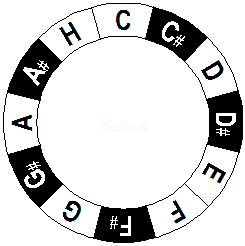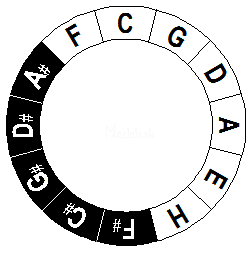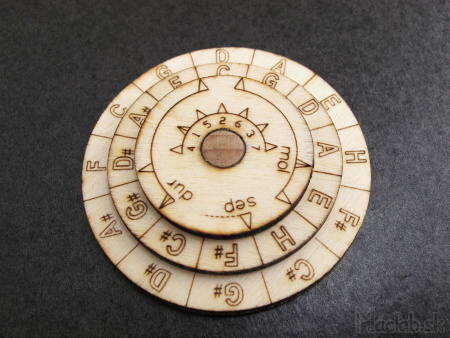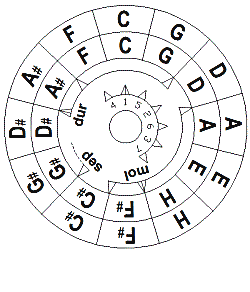Music tones, intervals, scales, and transposition tool
Even music has its own alphabet, the simplest scale is ABCDEFG. In some countries, letter B is replaced by H.We then took over from them what we get A H CDEFG. Since it is a C-major scale, it starts with tone C. In this form, it is also taught in music education:
C - D - E - F - G - A - H
Tone (music) scale has tones sorted by height. Tones are selected according to certain rules to match our hearing. The melody (composition) is then composed of a different combination of tones of a given scale. The C-major scale is made up of 7 CDEFGAH tones. We read it as " Do-Re-Mi-Fa-Sol-La-Si " The last eighth tone that we all learned in reality does not really belong, because it is from the next octave. It should be labeled C 2 . If we increase tones, the scale will begin to repeat in the second octave. We can also go through the third and fourth octaves until we can make it or if the musical instrument allows it.
C - D - E - F - G - A - H - C 2 - D 2 - E 2 - F 2 - G 2 - A 2 - H 2 - C 3 - D 3 - E 3 - F 3 . . .
Halftone
In fact, there are 12 basic tones (halves):
C - C # - D - D # - E - F - F # - G - G # - A - A # - H
Thus, the smallest tonal segment in music is such a halftone . The cross sign or the # # grid means that the whole tone, for example, C is increased by one halftone to get C # . We read it as " Cis ". There are two C and Dtones C # . The piano is a black halftone flap between the two white flaps.

We can also get the halftone so that we reduce the tone by halftone. The tone reduction is marked with the " b " mark. For example, if D decreases by halving, we get D b . We read it as " Des ". However, I b-éčka omit, because C increased by halftone sounds as D reduced by halftone. Therefore I will consider that C # = D b .Miscellaneous is written, but both tones are the same. It is said that they are " positively identical "
It's like I'm telling someone it's 7:30. So I'm going to spend half an hour for seven hours. Or I'll tell him that he's half eight. That's when I'm half hour away from the eight o'clock. Two different names, but time is still the same.
Frequency and pitch of the tone
If you press a key on the piano, a certain tone sounds. The tone is a sound with a fixed specific frequency.Frequency is the number of oscillations per second and is given in Hertz (Hz). Basically, it's a numeric value. The higher the number, the higher the tone. Each tone has its name and frequency. For example, A 4 = 440Hz .
The international standard precisely defines which tone should have the frequency. It's called tempered or absolute tuning. The basis is chamber A with an exact frequency of 440Hz . If we multiply this frequency by two, we get a double frequency tone that corresponds to the next octave.
The range of one octave is further divided into 12 base tones . Human hearing, however, perceives sounds at a logarithmic scale. Therefore, the frequency of each subsequent tone is multiplied by two to twelve, which is approximately 1.059. In this way, the whole table is scanned.
While it may seem that all possible tones are endlessly many, they are actually used less than a hundred. Too low frequencies below 20Hz are already too deep and below the hearing threshold for the human ear. On the contrary, too high tones above 15000 Hz are already too scratchy, and above 18000 Hz are already above the audible range.
![tabuľka frekvencií tóny v [Hz]](kvartovy_kruh/tabulka.png)
Tone frequencies are used in tuners. Ladder is an electronic device, but it can also be an application installed on a smartphone. If you play a tone in the tuner microphone, the tuner will measure its frequency, and on the screen it will immediately show which tone it is and whether the musical instrument is tuned.
Intervals and pitch shifts
Tone interval means shifting a number of halftones between two different tones. The distance of two halves gives one tone. Moving about 12 halves we get an octave. The octave means that we get a tone that appears to us as though it is, but clearly we hear it as higher. If something repeats all the time, it will best appear on the circle.Moving the circle clockwise increases the tone and decreases in the opposite direction. Such an upward method of arranging the tones is called a chromatic circle .

If we increase the C tone by 4 halves (the shift interval is 4 segments in the clockwise direction), we get the Etone. But if we increase the D tone by 4 halves, then we get the F # tone. Well, we suddenly get the same tone, instead of the whole tone, the tone with the grid. This is due to the fact that the white flaps of the whole tones are in a uniform spacing (one next to the other), but the black halftone flaps somewhere are missing, which then causes the difference.
This is illustrated by a keyboard with numbers that represent the shift interval. You can try to grab the scale on one line of guitar, with the number being the order of the fret.

Transpose tones
And what is the good tone shift? For example, if someone can not sing a song that is too deep, they have to sing a little higher. Or if he has a melody that he can not play on the whistle because it lacks the last hole with some tone. We can not move the tones as though, but we have to follow the shift rules of halftone intervals otherwise it will not match. We call this shift a transposition . We can easily move the movement around the chromatic circle . If we have a melody and all the tones that occur in it, we have shifted the same interval, we say we have transposed the song of a new one.
Another way of arranging the tones is the quartz circle . The tones are aligned on the circle no longer according to the height, but according to the sound, so that the neighboring tones form a quartet. The quartet is a 5-pointshift in the clockwise direction, which is the same as the pitch movement , i.e. 7 halves counterclockwise.Therefore, such an arrangement is also called a flower ring or a quartz circle .

Transposition can be done on the quentum circle just like on the chromatic circle by moving around the circle at certain intervals . Someone can translate the tones right out of the box, by identifying the quarters of the spam circle. If the notes are written on a computer by a scoring program, the song can be transposed in software. The computer enters a shift interval and automatically transmits the tones to a new tone.
Mechanical counter for transposition
For transposition without counting intervals, I have created a simple learning tool. It is a quint of a circle in which it is the same but a smaller circle. The circles can be rotated mechanically relative to each other. To make use of the place, I added a third small inner circle. All the major chords, the seventh sept, the chords and the tone scales can be found on it.
At the beginning, I did a few prototypes for testing.

Quarter Circle Drawing Downloads: DXF, PDF, PNG

In terms of construction, the large and small wooden circle is firmly connected by a wooden eye. Rotate only with the middle circle. When transposing, large and middle circles are rotated toward each other, with a one-shot shift being a half pitch shift. In search of chords and towards himself, he shoots a medium and a small circle. The small circle has solid chord spacings, with the hatched triangle indicating the beginning and the chord name. It's best to see the animation below.


Another option is to build a spiner ring. Drawing Download PNG